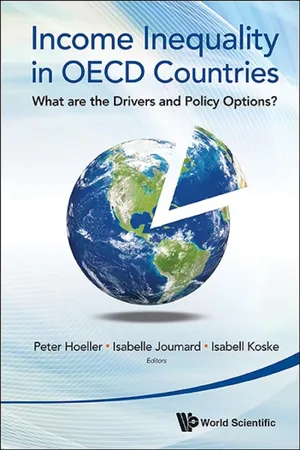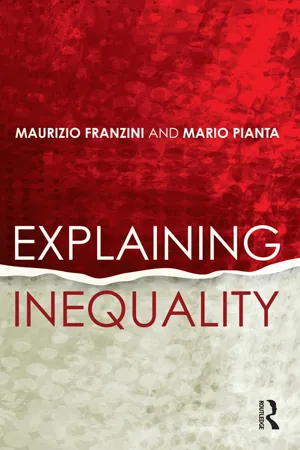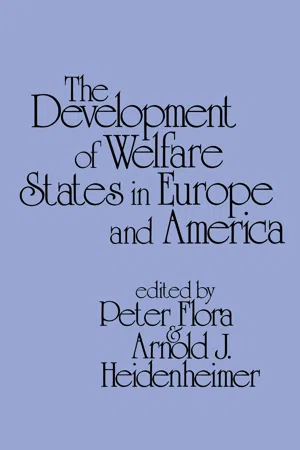Economics
Distribution of Wealth
The distribution of wealth refers to how assets and resources are divided among individuals or groups within a society. It encompasses the unequal allocation of income, property, and other forms of wealth. This distribution is a key focus in economic analysis and policy-making, as it can have significant implications for social and economic stability.
Written by Perlego with AI-assistance
Related key terms
5 Key excerpts on "Distribution of Wealth"
- eBook - ePub
- Martin Bronfenbrenner(Author)
- 2017(Publication Date)
- Routledge(Publisher)
CHAPTER TWOVariations on the “Distribution” Theme
Economics vs. Business: Income vs. Wealth
1. The distribution of income, of wealth and of such related entities as “wages” or “liquid assets,” means, in economics, its division among various social groups and classes, usually in consequence of the workings of an economic system. This usage contrasts in a confusing way with the meaning of the term distribution in business administration. There it relates to the physical process of distributing goods from their point of production to their points of consumption, and may be used synonymously with “marketing.” In these chapters, we follow the economic usage; from this viewpoint, such questions as “Does distribution cost too much?” are meaningless.It is important to distinguish between the distribution of income and that of wealth, although academic practice used “wealth” in both senses as recently as World War I, and popular practice still does so. Income is conventionally regarded as a flow of returns from human and nonhuman assets alike, while wealth is a stock of nonhuman assets (plus slaves, a human asset, where the institution of slavery survives) and an increment of wealth is a component of income.1 The distributions of income and wealth differ widely, depending (chiefly) on the importance of “human capital” as an income-earning asset, and on the rate of return obtained as income in different societies.Comparing the United States and the United Kingdom, for example, the distribution of income, as commonly measured, is more unequal in the United States, while the Distribution of Wealth is more equal there.2 An incomplete and superficial explanation of this disparity is the greater concentration of British wealth in residential housing and other forms of “consumer capital” whose returns, if any, are not recorded as income. Comparing capitalist and socialist states, the major differences in distribution seem to apply to wealth and, on the income side, to the property income directly derived from wealth. These differences result from the drastic restrictions imposed under socialism upon private opportunities to hold earning assets in “commodity production,” and to retain income from this source.3 - eBook - ePub
Income Inequality In Oecd Countries: What Are The Drivers And Policy Options?
What are the Drivers and Policy Options?
- Peter Hoeller, Isabelle Joumard, Isabell Koske(Authors)
- 2013(Publication Date)
- WSPC(Publisher)
• The countries with the most unequal income distribution are not necessarily those with the most unequal wealth distribution. Among the countries covered in this study, wealth inequality is particularly high in Sweden and the US and is the lowest in Italy.• In all countries, assets are a more important contributor to overall wealth inequality than debt. Nonfinancial assets contribute more than financial assets, even though financial assets are more unequally distributed in all countries. This is explained by the higher share of nonfinancial assets in total assets.• Wealth inequality has trended down during the 20th century until the mid-1970s to early 1980s, from which point wealth inequality has been rising. The rise in inequality reflects (i) soaring financial markets in the aftermath of financial market deregulation that started in the 1970s; (ii) lower marginal tax rates on top incomes and lower capital gains and wealth taxation which have made the accumulation of wealth easier for the rich; and (iii) at least in France, inheritances and inter vivos gifts have risen again in importance over the past 30 years and stood at nearly 15% of national income in 2008, nearly as high as a century ago.Measuring the Distribution of Wealth
Wealth can be measured in different ways. Marketable wealth is the narrowest concept and includes only assets that generate capital income. Another possibility is to consider household disposable wealth which is the market value of assets minus liabilities that are directly tradable, with housing considered liquid enough to qualify. Augmented wealth is the most encompassing concept both in the time dimension, as it includes the present value of all discounted future income, and in the number of assets considered as both pension rights and human capital are also included. However, given data limitations, studies generally define wealth as household net worth, the sum of household financial and non-final assets minus debt, which is the concept used here.This implies that the value of pension rights and life insurance are excluded from the analysis. However, from a life-time perspective, assets that underpin future consumption should also be included. And not only is an important part of wealth left excluded, the cross-country comparability of the data is also reduced since the omission will bias results less in countries where individuals save more for their retirement outside the public pension scheme. - eBook - ePub
- Maurizio Franzini, Mario Pianta(Authors)
- 2015(Publication Date)
- Routledge(Publisher)
2Capital, Labour and the Distribution of Income2.1 Introduction
Inequality starts with the way the economy is organised and income is distributed. In this chapter we show that advanced countries during the last 30 years have been characterised by a major change in the patterns of distribution resulting from market outcomes: the share of income going to capital has increased and the share going to labour has fallen. This ‘functional’ distribution of income going to the ‘factors of production’ (capital and labour) can then be investigated in the way it reaches individuals and households – who can receive both capital and labour incomes – leading to the ‘personal’ distribution of income emerging from market outcomes. Household income, in turn, is modified by taxation and redistribution (pensions and welfare payments) leading to the distribution of disposable (monetary) income. The presence of non-market activities should be taken into account. When public services such as education and health are provided to all as a citizen right paid by taxation, they reach all individuals on the basis of their needs rather than on their ability to pay, exerting an important ‘equalising’ effect; disposable income can therefore be adjusted with the ‘value’ of in-kind services provided by the welfare state. In this way we can measure inequality among households after the effects of all available policies.Inequality can increase as a result of different processes. In advanced countries the dominant pattern has been the rise of ‘top incomes’ – those of the richest 10 per cent or 1 per cent of the population – that have accelerated at an unprecedented rate, leaving behind the rest. They have typically combined high returns from financial investment and strong capital gains from the increased value of financial and real estate wealth. Top managers and other ‘star’ professionals have also obtained unprecedented compensations for their activities that combine a remuneration for their labour, a rent from their social and professional power and a share of the profits often delivered in the form of stock. It is on this process that the analysis of Piketty (2013) has focused. - Peter Flora(Author)
- 2017(Publication Date)
- Routledge(Publisher)
Part FourEconomic Equality: The Distribution of Incomes
Passage contains an image
Chapter 6
The Historical Development of Income Inequality in Western Europe and the United States
Franz KrausI. Problems in Examining Income Inequality
A. Defining Income Distribution
Today material welfare is much less dependent on market incomes or rewards for labor and property in the production process than in earlier times. Direct and indirect taxes, transfer payments, and the provision of public services—all consequences of the growth of the welfare state—have clearly weakened the importance of wages and assets in determining economic status. To analyze income inequality with respect to the development of the welfare state, we must distinguish between a producer inequality that simply refers to market incomes, and a consumer inequality that reflects the final distribution of income after taxes, transfer payments and the consumption of public goods have been taken into account.To assess income inequality from a comparative and historical perspective, we must ask how these two fundamental aspects of economic inequality differ from each other, how they vary between countries, and how they have changed over time. Furthermore, we want to examine the relationships between producer inequality and consumer inequality: who finances, and to what extent, public expenditures, and who benefits, and to what extent, from transfer payments and public goods?Because of the shortcomings of available sources, particularly for previous periods, quantitative assessment of the extent men benefit from public goods is most difficult.1 Similarly it is difficult to estimate the impact of public expenditures on income inequality through changes in factor demand and supply, such as the extension of public education or the civil service. However, if we leave aside these more qualitative questions, we can still learn much from analyzing the successive steps by which producer inequality is transformed into consumer inequality. Figure 6.1 2 provides a simplified overview3- eBook - ePub
Economic Inequality and Poverty: International Perspectives
International Perspectives
- Lars Osberg(Author)
- 2017(Publication Date)
- Routledge(Publisher)
4The Distribution of Household Wealth: Methodological Issues, Time Trends, and Cross-Sectional ComparisonsEdward N. Wolff1. Introduction
There has been renewed interest in the subject of wealth distribution in North America and Western Europe in the last several years. In the United States, for example, there has been a virtual explosion of surveys on household wealth over the last ten years. Results from these surveys have appeared in newspapers and magazines around the country and generated considerable controversy and attention.In this paper, I will focus on methodological and factual issues connected with the distribution of household wealth: (1) What is the proper definition of wealth? (2) What are the most effective methods for estimating the size Distribution of Wealth from available data? (3) Has there been any historical movement towards greater equality in the distribution of household wealth? (4) Is it proper to include measures of retirement wealth in the household balance sheet and, if so, how do such assets affect overall inequality in the size distribution of household wealth? (5) Since families tend to accumulate wealth over time, how important, empirically, is age in explaining differences in household wealth? (6) Do there appear to be significant differences in the concentration of wealth among industrialized countries? There are four findings of particular note that emerge from this survey. First, the degree of wealth inequality among households declined from the early 1920s through the 1970s. This observation is based on data for Sweden, the United Kingdom, and the United States, the only countries for which such long time-series information is available. The share of total household wealth held by the top 1 percent of wealth holders declined from 50 percent in 1920 to 21 percent in 1975 in Sweden, from 61 percent in 1923 to 23 percent in 1974 in Great Britain, and from 38 percent in 1922 to 19 percent in 1976 in the United States. Second, since the mid-1970s or so, the degree of wealth inequality has remained relatively constant in the United Kingdom and has risen in Sweden and the United States. Third, despite the decline in wealth inequality since the early part of this century, household wealth is still highly concentrated today. In the mid-1970s, the richest 1 percent held a quarter of all household wealth in France and the United States, over 30 percent in the United Kingdom, and about a fifth in Sweden. Indeed, household wealth is considerably more concentrated than household income. Fourth, attempts to account for the high degree of wealth inequality in these countries on the basis of age and other demographic factors have yielded very
Learn about this page
Index pages curate the most relevant extracts from our library of academic textbooks. They’ve been created using an in-house natural language model (NLM), each adding context and meaning to key research topics.




